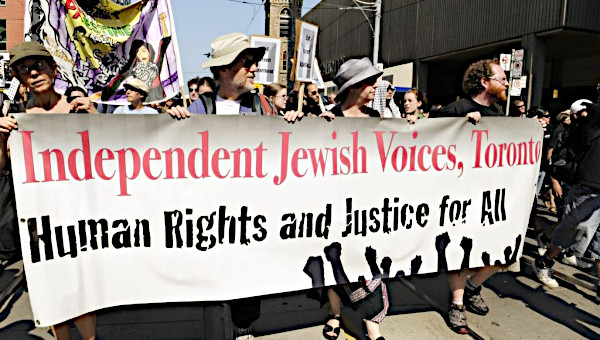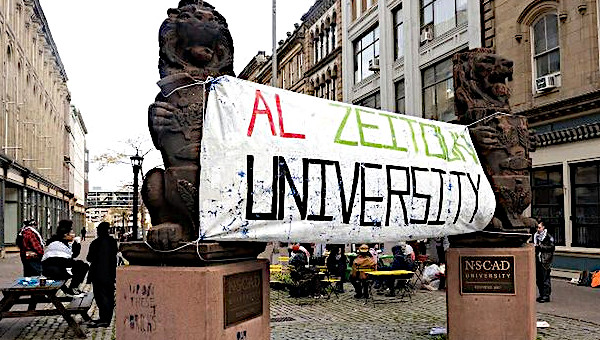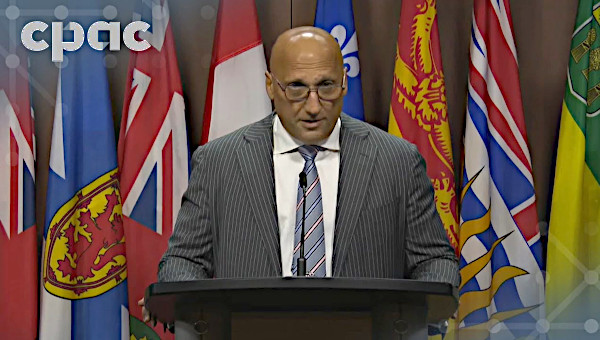Toward A New Politics? After the CAW-NDP Divorce
On April 21, 2006, the Canadian Auto Workers (CAW) broke with a tradition that extended over half a century and voted to leave the New Democratic Party (NDP). A few CAW activists shrugged their shoulders: the impact of the NDP on their daily struggles had been minimal and so setting it aside did not seem to matter much. Others, including a significant section of the Canadian Left, were outraged: leaving was a mistake because electoral politics remains crucial to our lives. We must, they argued, focus our response on getting back in.
A third perspective, which may turn out to be the most lasting and important aspect of the CAW leaving the NDP, was that this exit created an opening for those frustrated with what has recently passed for ‘politics.’ The auto workers have a long history of independent working class activism inside and outside of electoral politics; the break with the NDP poses the question of how today’s activists, confronting new pressures and the disappointments with the NDP, might contribute to creatively and concretely building on that earlier legacy of the union. Before elaborating on this, however, it is useful to return to the CAW’s decision to leave its traditional political home and assess what that move was actually about.
The CAW Exit: A Move to the Left?
The ostensible reason for leaving the Ontario NDP was that the party had unfairly expelled the union leader, Buzz Hargrove, for supporting Liberals during the election. The NDP did indeed act inconsistently; numerous other party members had also supported Liberal candidates without sanctions. Yet, did it make sense to let a particular spat lead to a reversal of an historic commitment to social democracy? If the debate was only over some tactic, then why not, for example, protest the NDP’s decision by withholding dues or by mobilizing to reverse the rather intemperate and daft decision the party had made? The point of course is that something larger was in fact going on: the CAW leadership was clearly moving away from the NDP before the ouster of Hargrove, and the NDP conveniently gave the CAW president the incident to formalize the rupture.
The union did subsequently explain its position in broader terms. It suggested that it had shifted from support for a tepid social democracy and narrow electoralism, toward a more explicit ‘movement politics.’ But the most visible signs of CAW involvement in the election had little to do with education of the members and movement building; rather, the election will be remembered for the presence of Paul Martin at the CAW convention, the smiles and hugs as the CAW president bestowed Martin with a CAW jacket, and the extent to which this left the membership confused, divided, and cynical. In the eyes of many activists – both inside and outside the CAW – the union’s politics are increasingly driven by pragmatism, not an expansive vision. In the auto industry in particular, where the union put its main energy into lobbying for money for the Big Three, the union seems to have gotten uncomfortably close to both the corporations and the Liberals.
In defending his electoral role during the 2006 Federal election, CAW President Buzz Hargrove has been able to call on a resolution passed by national delegates to the CAW Canadian Council. The NDP’s response, Hargrove argued, was therefore not just an attack on him personally, but a direct challenge to the overall union and its democratic autonomy. It is interesting to note, however, that while the actual resolution explicitly called on delegates to ‘endorse sitting NDP members’ as well as NDP candidates in ‘winnable ridings,’ it stated that in other ridings, ‘the CAW will not endorse any specific candidates.‘ In this context, the support given to Liberal candidates Belinda Stronach of Magna and a Toyota executive – both representatives of notoriously anti-union companies – was not only politically questionable in terms of the union’s long-standing challenge to anti-union employers, but debatable even in terms of the wording and intent of the resolution.
The CAW leadership nevertheless insisted that it was in fact moving to the left and pointed to its new internal structures – Union in Politics Committees or UPCs – as the basis for ‘a new way of doing politics’. But the UPCs had in fact been established back in September 2004 (a further reminder that the tensions with the NDP were not new). In the more than two years since, they have been disappointingly dormant. To be fair, there have been a number of well-received training sessions for these committees; the CAW’s commitment to membership education remains unparalleled, and local CAW activists continue to play impressive roles in specific campaigns such as those around health care. Yet, without a larger overall commitment to challenging the status quo and a clear turn away from elite-oriented politics, the stagnation of the UPCs is virtually inevitable (the staff member assigned to act as a catalyst for the mobilization from below tellingly ended up concentrating his efforts on acting as the union lobbyist in Ottawa).
A ‘new politics’ would have meant more than rejecting the NDP and replacing it with new but lifeless structures. It would have included:
- Actively engaging its members in the process of developing an alternative (anti-capitalist) vision.
- Overcoming the CAW’s isolation from the rest of the labour movement, without whom any new politics is fundamentally limited.
- Asking what it means to link up with ‘other movements.’ Are they simply ‘others’ or do they speak to other dimensions of our own member’s lives, such as health, the environment, war?
- Putting union organizing into the broader context of building the working class as a whole and addressing how to ‘organize’ the members who are already unionized
- Moving to a platform that included coping with our relationship to the U.S. – an issue that can’t be ignored in any serious reorientation of Canadian society. This would overlap international political issues (the U.S. invasion of Iraq, Canada’s role in Afghanistan, challenging the U.S.-supported Israeli denial of Palestinian national rights); domestic ‘economic’ issues (free trade, democratic control over investment, Canadian energy policy) and domestic human rights issues (immigration and civil rights in the context of the extension into Canada – with the support of the Canadian government – of the U.S. ‘security’ state).
In short, raising the possibility of a new politics can’t help but raise rethinking the place of unions within today’s local and global struggle against neoliberalism. And alongside this addressing (a) how unions think about their members and their member’s role in the organization and (b) the adequacy of union’s structures – including structures for democratic debate and participation – to the challenges currently confronting unions and working people.
It is true enough that the NDP had moved to the center. The irony is that in leaving the NDP, the CAW leadership was hardly breaking new ground on the left, but rather also moving, in its own way, to the center.
Back to the Party?
The frustrations with formal politics are certainly understandable. But bad politics is not a reason to give up on any politics. We take it as obvious that electoral politics and the state are too important to leave to Canada’s elite. And we take it as equally obvious that single-issue lobbying or one-off mass events – as important as they are to an overall politics – do not in themselves really constitute a serious challenge to the status quo. Ignoring the question of political power is therefore suicidal in terms of social progress. The question of how we organize ourselves to simultaneously defend ourselves AND develop the kind of capacities that can eventually address state power is therefore the most important political question we can ask.
However, fighting to get back into the NDP represents a step backwards. The NDP has not and cannot address the political task we face. This is, to begin with, not just a shortcoming in the Canadian NDP but something much more general. It’s a failure that has characterized every social democratic party in the world. Coming to grips with that failure involves recognizing that social democracy is not a milder form of socialism which has lost its way or radicalism, but a political project rooted in a particular vision, ideology, culture, and set of structures and practices. The two inter-related cornerstones of social democracy are that, first, social democracy doesn’t really believe that capitalism can be transformed and second, even if capitalism could be transformed, social democracy doesn’t believe that the working class can ever develop the political will and capacity to play a central role in such a transformation. And so, social democracy is left with the cramped vision of administering neoliberalism with a human face, and the cramped politics of workers’ needing to only know who to vote for.
This failure has a long history but it has been particularly exposed in the neoliberal period. Policy options under capitalism have, over the past quarter century, been polarized: the middle ground has given way. Corporations and their representatives have come to understand this and have responded decisively and aggressively. Social democracy never reached such an understanding – or when it did, it was awed at the implications and retreated.
One result of this was that the political initiative over the past two decades shifted to the non-electoral actions of unions and the social movements (with the CAW playing a very prominent role). This was first seen in the fight against the Canada-USA Free Trade Agreement in the mid-1980s, where it was the unions and movements that led this most political fight with the NDP largely tagging along behind. The political leadership of the unions and the movements was further reinforced in the creative Days of Action in the mid-1990s against the Harris cutbacks, by which time no-one even looked to ‘labour’s political arm’ to lead any non-electoral political mobilization.
There are many on the left who would not disagree with the above analysis yet would insist that since the ‘most advanced’ sections of the working class movement remain in the NDP, that’s where the politics of all progressives must also gravitate. This is an argument that cannot be discounted, especially at a time when no alternative political party seems on the horizon. The NDP is certainly not the enemy and the activists that remain in the NDP must be respected enough to continue to engage them in discussions and debates, to join with them around particular campaigns, and even to vote NDP at election time given the options. But we must do so without any illusions. The reality is that to the extent that many committed activists are in the NDP, the NDP also serves to limit their expectations and to mis-educate them on social possibilities and political potentials.
Taking ‘A New Politics’ Seriously
The issue therefore is not to return to the NDP, but to start addressing how to go beyond the NDP.
The political choices we confront today are not real choices because we don’t in fact have the political capacity to implement them and – more distressing – we haven’t figured out a way of developing such capacities. At some point we are going to have to build a new political organization. This doesn’t just mean another party, but a different kind of party. We need a party that addresses how we build our collective political capacities, to not only come to power, but to do so with the intent of using that political power to transform states so they are democratic in the fullest sense – supporting the continued development of our collective capacity to transform and democratize our workplaces and communities and contribute to genuine global solidarity. That is, to move towards replacing capitalism.
What kind of party might this be? What kinds of relationships, structures and struggles should we be creating and experimenting with now, so that kind of party might be possible in the future? How do we bridge our immediate needs for self-defence with such a longer-term project? Might it, for example, make sense to begin by setting up ‘People’s Assemblies’ – regular meetings of representatives of the various progressive groups, including union locals, in each community – to provide mutual support, share and expand resources, determine some common priorities, and work to the development of a common platform?
The CAW’s reasons for leaving the NDP may, as we’ve suggested, have had nothing to do with posing such questions. But the contradictions inherent in the CAW leadership’s determination to leave the NDP may have created an opening for going beyond a return to the NDP. We need to sustain this debate – in the pages of Relay, Canadian Dimension and elsewhere, for the politics of limited social coalitions, social forums, single-issue protests, organized Leninist groups, and hope for a spontaneous anti-globalization rebellion have not formed into alternatives to neoliberalism – and invite fuller discussion of new possibilities. •





